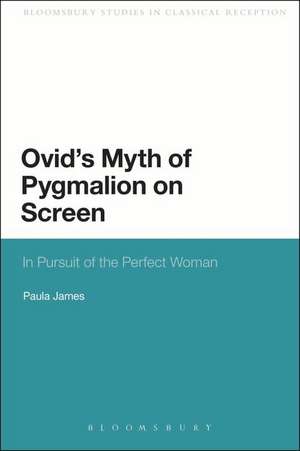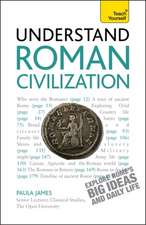Ovid's Myth of Pygmalion on Screen: In Pursuit of the Perfect Woman: Bloomsbury Studies in Classical Reception
Autor Dr Paula Jamesen Limba Engleză Paperback – 27 mar 2013
| Toate formatele și edițiile | Preț | Express |
|---|---|---|
| Paperback (1) | 185.19 lei 6-8 săpt. | |
| Bloomsbury Publishing – 27 mar 2013 | 185.19 lei 6-8 săpt. | |
| Hardback (1) | 890.72 lei 6-8 săpt. | |
| Bloomsbury Publishing – 5 oct 2011 | 890.72 lei 6-8 săpt. |
Din seria Bloomsbury Studies in Classical Reception
-
 Preț: 90.70 lei
Preț: 90.70 lei - 14%
 Preț: 180.44 lei
Preț: 180.44 lei - 30%
 Preț: 598.52 lei
Preț: 598.52 lei - 11%
 Preț: 218.91 lei
Preț: 218.91 lei -
 Preț: 90.37 lei
Preț: 90.37 lei - 22%
 Preț: 225.77 lei
Preț: 225.77 lei - 11%
 Preț: 220.75 lei
Preț: 220.75 lei - 30%
 Preț: 540.31 lei
Preț: 540.31 lei - 22%
 Preț: 224.94 lei
Preț: 224.94 lei - 22%
 Preț: 237.75 lei
Preț: 237.75 lei - 30%
 Preț: 597.63 lei
Preț: 597.63 lei - 22%
 Preț: 224.03 lei
Preț: 224.03 lei - 21%
 Preț: 218.74 lei
Preț: 218.74 lei - 21%
 Preț: 218.65 lei
Preț: 218.65 lei - 22%
 Preț: 225.96 lei
Preț: 225.96 lei - 21%
 Preț: 218.47 lei
Preț: 218.47 lei - 30%
 Preț: 569.76 lei
Preț: 569.76 lei - 21%
 Preț: 217.62 lei
Preț: 217.62 lei - 20%
 Preț: 219.57 lei
Preț: 219.57 lei - 30%
 Preț: 541.85 lei
Preț: 541.85 lei - 18%
 Preț: 166.36 lei
Preț: 166.36 lei - 30%
 Preț: 569.60 lei
Preț: 569.60 lei - 23%
 Preț: 254.55 lei
Preț: 254.55 lei - 30%
 Preț: 599.41 lei
Preț: 599.41 lei - 22%
 Preț: 261.08 lei
Preț: 261.08 lei - 22%
 Preț: 260.16 lei
Preț: 260.16 lei - 30%
 Preț: 598.02 lei
Preț: 598.02 lei - 30%
 Preț: 569.70 lei
Preț: 569.70 lei - 21%
 Preț: 218.65 lei
Preț: 218.65 lei - 30%
 Preț: 568.22 lei
Preț: 568.22 lei - 22%
 Preț: 772.98 lei
Preț: 772.98 lei
Preț: 185.19 lei
Preț vechi: 241.00 lei
-23% Nou
Puncte Express: 278
Preț estimativ în valută:
35.44€ • 37.13$ • 29.29£
35.44€ • 37.13$ • 29.29£
Carte tipărită la comandă
Livrare economică 11-25 aprilie
Preluare comenzi: 021 569.72.76
Specificații
ISBN-13: 9781472504951
ISBN-10: 147250495X
Pagini: 248
Ilustrații: black & white illustrations
Dimensiuni: 156 x 234 x 13 mm
Greutate: 0.35 kg
Editura: Bloomsbury Publishing
Colecția Bloomsbury Academic
Seria Bloomsbury Studies in Classical Reception
Locul publicării:London, United Kingdom
ISBN-10: 147250495X
Pagini: 248
Ilustrații: black & white illustrations
Dimensiuni: 156 x 234 x 13 mm
Greutate: 0.35 kg
Editura: Bloomsbury Publishing
Colecția Bloomsbury Academic
Seria Bloomsbury Studies in Classical Reception
Locul publicării:London, United Kingdom
Caracteristici
Uniquely traces the influence of Ovid's Pygmalion upon film and television narratives, discussing what fresh and fascinating perspectives modern texts can give upon Ovid's retelling of the myth and its subsequent trajectory through centuries of culture.
Notă biografică
Paula James is Senior Lecturer in Classical Studies at The Open University, UK, and has published widely in Latin Literature and on the reception of classical motifs in popular culture. She has appeared on 'Women's Hour' on Radio 4 to talk about her previous book The Role of the Parrot in Selected Texts from Ovid to Jean Rhysand has also appeared on Radio 3's Greek and Roman Essay series, speaking on Cicero.
Cuprins
Acknowledgments \ Introduction \ 1. Ovid's Rich Text - Layers of identity in the Pygmalion myth \ 2. Tragic Transformations: Making and breaking the statue on screen \ 3. Romancing the Stone: The made-over woman as comedy \ 4. She was Venus all along: The statue as screen goddess \ 5. Pygmalion's robots - The horror and the humour \ 6. Bathos and Pathos - A simulacrum among simulacra \ 7. Virtually Perfect: Hi and lo tech gals of the computer age \ 8. More Myth Making at the Movies \ Appendix: Ovid's Pygmalion \ Bibliography \ Filmography \ Index
Recenzii
Paula James has produced a brilliant and engaging study of how and why the modern media of film and television continue to refashion ancient mythological narratives for contemporary audiences, in this case, Ovid's story of Pygmalion and his ivory statue come to life. In a series of provocative and detailed chapters, James expertly examines an array of cinematic and televisual texts - from classic films like Vertigo (1958) to more recent screen productions such as Lars and the Real Girl (2007) and Buffy the Vampire Slayer (1997-2003) - that correspond on both the narrative and figurative levels to Ovid's myth of the "made-over woman." James deftly unravels the myth's infinite and powerful layers as she explores the popular genre of "make-over films," while delving into the question of our eternal fascination with the theme of artfully - or artificially - created life and the problems of "perfection" inherent in the eyes of the beholder. With the analytical skills of a classicist and the ardor of a film fan, James succeeds in assessing both the impact of the classical myth on modern viewers, as well as how each onscreen reception in its current cultural context sheds further interpretive light on the ancient story. Monica S. Cyrino, University of New Mexico, USA
The story of Elisa Doolittle, the working class flower girl transformed into the image of a Duchess by Professor Higgins, was made famous by the 1964 musical My Fair Lady. In her excellent book, Paula James positions this story within a more complex and long standing literary and cinematic tradition. Beginning with Ovid's epic poetry and his version of the Pygmalion myth, James explores how the narrative trope of the make-over has been repeatedly reworked and re-imagined on screen. Bringing together an exciting range of literary, cinematic, and televisual texts as diverse as Pygmalion, Vertigo, Pretty Woman, Miss Congeniality and Buffy the Vampire Slayer, James offers an insightful discussion of the perennial cultural need to fashion and re-fashion women into a fantasy ideal. Scholarly and engaging, this book will make you look at these texts, whether classical or pop culture, like never before. Stacey Abbot, Reader in Film and Television Studies, Roehampton University, London, UK
Drawing on an impressive range of scholarship, James generously acknowledges the work of others as well as forming her own conclusions surrounding the ultimate inadequacies of the created feminine ideal.. The book explores the ongoing fascination with Ovid's Pygmalion story, explains why it still has powerful resonances today and, furthermore, suggests how its new reworkings can illuminate readings of Ovid's Metamorphoses itself.
The fortunes of the Pygmalion story in literature and the fine arts have been well canvassed over the years; James provides the most extensive coverage so far for film and television.
The story of Elisa Doolittle, the working class flower girl transformed into the image of a Duchess by Professor Higgins, was made famous by the 1964 musical My Fair Lady. In her excellent book, Paula James positions this story within a more complex and long standing literary and cinematic tradition. Beginning with Ovid's epic poetry and his version of the Pygmalion myth, James explores how the narrative trope of the make-over has been repeatedly reworked and re-imagined on screen. Bringing together an exciting range of literary, cinematic, and televisual texts as diverse as Pygmalion, Vertigo, Pretty Woman, Miss Congeniality and Buffy the Vampire Slayer, James offers an insightful discussion of the perennial cultural need to fashion and re-fashion women into a fantasy ideal. Scholarly and engaging, this book will make you look at these texts, whether classical or pop culture, like never before. Stacey Abbot, Reader in Film and Television Studies, Roehampton University, London, UK
Drawing on an impressive range of scholarship, James generously acknowledges the work of others as well as forming her own conclusions surrounding the ultimate inadequacies of the created feminine ideal.. The book explores the ongoing fascination with Ovid's Pygmalion story, explains why it still has powerful resonances today and, furthermore, suggests how its new reworkings can illuminate readings of Ovid's Metamorphoses itself.
The fortunes of the Pygmalion story in literature and the fine arts have been well canvassed over the years; James provides the most extensive coverage so far for film and television.


















